WorkChairs, an ergonomic product business in Studio City, California, specializes in selling hard-to-find ergonomic products to the local community and online. Owned by Jake and Lisa Wilson, WorkChairs operates with one other employee, Peter Wilson.
Using two sales channels, WorkChairs focuses on niche products that address ergonomic health problems arising from increased computer use. Through local marketing and sales techniques, WorkChairs aims to establish a strong customer base in the home office, small business, and large business communities. Additionally, WorkChairs plans to utilize manufacturer relationships for drop-shipping and offer an educational section on their website to educate customers about ergonomic problems.
With a conservative financial plan, low expenses, low payroll, and a conservative sales forecast, WorkChairs aims to maintain a positive cash balance while gradually increasing total cash and company net worth.
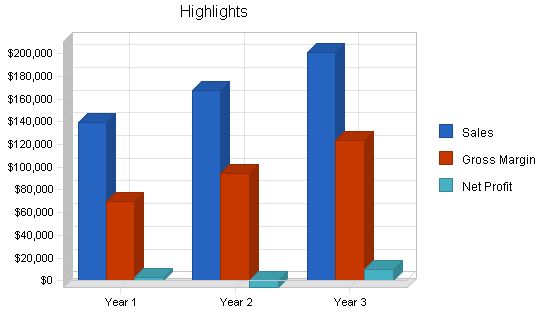
WorkChairs is a specialty ergonomic product retailer in the local and online market. Our mission is to provide quality products that create a healthy work environment, preventing injury and pain. Our goal is to keep customers happy and solve their problems with great products at an affordable price.
Additionally, we strive to educate customers on ergonomic issues to prevent future discomfort. We take pride in this approach both personally and professionally.
To achieve success, we:
– Offer specialty products not available at large retailers like Office Max, Office Depot, Staples, Costco, and Ikea, focusing on niche items that cannot be found at these stores.
– Provide excellent customer service to retain health-conscious customers who are aware of the benefits of ergonomic products.
– Maintain slow and organic growth to control expenses and operate efficiently.
– Build an easy-to-use website that effectively sells our products and educates customers.
Our objectives include:
– Achieving profitability after six months of operation.
– Becoming the market share leader for specialty ergonomic products in the local market.
– Having our website rank among the top five websites for specialty ergonomic products in terms of traffic and sales.
– Creating a fun and comfortable work environment for our customers.
WorkChairs is a small business based in Studio City, CA. We sell specialty ergonomic products both locally and online. The company is owned by Jake and Lisa Wilson, who run the business from their home. Their son, Peter, is also part of the company.
The start-up expenses for WorkChairs include legal fees, stationery, sales brochures, insurance, computer equipment, and a domain name. Jake and Lisa Wilson will provide the necessary investment to cover these expenses and have a cash reserve. Our start-up phase does not include any liabilities, and we will have minimal inventory on hand, only purchasing examples of our products for customers to test-sit.
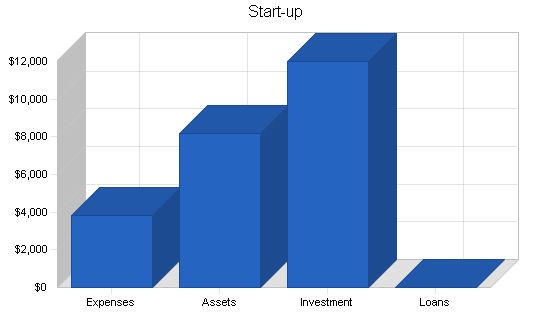
Start-up Requirements:
Legal: $1,000
Stationery etc.: $250
Brochures: $1,000
Insurance: $500
Expensed Equipment: $1,000
Domain Name: $75
Total Start-up Expenses: $3,825
Start-up Assets:
Cash Required: $6,175
Other Current Assets: $2,000
Long-term Assets: $0
Total Assets: $8,175
Total Requirements: $12,000
Start-up Funding:
Start-up Expenses to Fund: $3,825
Start-up Assets to Fund: $8,175
Total Funding Required: $12,000
Assets:
Non-cash Assets from Start-up: $2,000
Cash Requirements from Start-up: $6,175
Additional Cash Raised: $0
Cash Balance on Starting Date: $6,175
Total Assets: $8,175
Liabilities and Capital:
Liabilities:
Current Borrowing: $0
Long-term Liabilities: $0
Accounts Payable (Outstanding Bills): $0
Other Current Liabilities (interest-free): $0
Total Liabilities: $0
Capital:
Planned Investment:
Jake and Lisa Wilson: $12,000
Other: $0
Additional Investment Requirement: $0
Total Planned Investment: $12,000
Loss at Start-up (Start-up Expenses): ($3,825)
Total Capital: $8,175
Total Capital and Liabilities: $8,175
Total Funding: $12,000
Products:
WorkChairs sells niche ergonomic products that are hard to find at standard office furniture or office supply stores. Our primary products include:
– Chairs: A large number of specialty chairs built to solve various physical problems caused by sitting in an office chair all day. These chairs aim to solve back, hip, leg, neck, shoulder, arm, and wrist problems.
– Workstations: Computer and regular workstations specially designed to be ergonomically correct.
– Computer Accessories: Special mice, keyboards, glare screens, keyboard trays, wrist rests, monitor supports, and other computer accessories.
– Document Holders: Copy holders to allow the head to stay looking up at eye level.
– Foot Rests: Proper foot rests that complement ergonomic chairs for better posture alignment.
– Lighting: Various types of lighting to make things easier on the eyes while working.
– Back/Arm/Wrist Supports: Various supports for various reasons.
– Headsets/Microphones: For phone-related problems.
Market Analysis Summary:
As computer and office jobs become more common, the general working population will experience more health problems caused by improper office working environments. These problems may include wrists aching from typing, aching backs due to bad chairs, or damaged eyes from staring at computer screens. Ergonomic products focus on solving these problems. Unfortunately, these products are often hard to find at general furniture stores or office supply stores. WorkChairs aims to supply these products to both our local market and the online space.
Specifically, we’ll target a few different types of workers:
– The home office user.
– The small business office manager.
– The large organization purchasing manager.
Market Segmentation:
We have broken down our target market into the following categories:
– Home Office: This segment consists of people running businesses from their homes. We estimate there are about 20,000,000 home office businesses in the United States, with a 5% growth rate. Since we can reach the entire United States with our website, we have the potential to reach the entire market.
– Small Office Managers: The small office market is also quite large, with a 5% growth rate. Most of these businesses have office workers who would be in need of ergonomic products.
– Large Office Purchase Managers: This market segment is smaller in size but has huge potential for sales as purchase managers usually make bulk buying decisions for multiple workers. It has a slower 2% growth rate due to fewer large businesses being created.
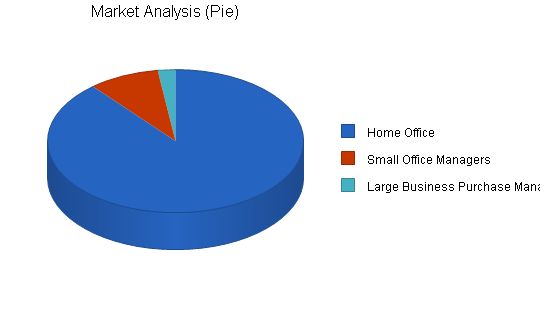
Market Analysis
| Market Analysis | |||||||
| Year 1 | Year 2 | Year 3 | Year 4 | Year 5 | |||
| 20,000,000 | 21,000,000 | 22,050,000 | 23,152,500 | 24,310,125 | |||
| 2,000,000 | 2,100,000 | 2,205,000 | 2,315,250 | 2,431,013 | |||
| 500,000 | 510,000 | 520,200 | 530,604 | 541,216 | |||
| 22,500,000 | 23,610,000 | 24,775,200 | 25,998,354 | 27,282,354 | |||
4.2 Target Market Segment Strategy
The following are our market segments and our reasoning for targeting each segment:
– Home Office: This large segment consists of people spending long hours on a computer, making them prime targets for ergonomic equipment. These individuals are more likely to invest in nicer furniture and equipment for their home offices.
– Small Business Managers: Most small businesses have a manager in charge of equipment purchasing decisions. These managers can be educated on the benefits of ergonomic equipment, and they usually try to keep costs low.
– Large Business Purchase Managers: While harder to reach, large businesses have purchase managers who can be responsible for significant sales. These managers often buy equipment in bulk and have budgets for quality purchases.
The ergonomic industry is growing as the use of computers increases in offices. People are experiencing health problems from repetitive computer use throughout the day. As a result, knowledge of ergonomic products is increasing.
The ergonomic product manufacturing industry is also growing, with more companies offering new products at lower prices.
WorkChairs aims to sell locally to small and large businesses, as well as serving these markets and the home office market online. We believe this combination of local and nationwide sales will provide a solid foundation for our business.
4.3.1 Competition and Buying Patterns
People shopping for ergonomic products consider the following criteria:
– Product selection: They want a company that offers a variety of ergonomic products, including different brands.
– Price: Ergonomic products are often more expensive than expected, so price is a significant factor.
– Customer service: Customers have questions about ergonomic products and need informative websites and easy contact options. Providing excellent local customer service is also essential.
Strategy and Implementation Summary
The primary strategies of WorkChairs are:
– Selling niche ergonomic products that are hard to find elsewhere and require education to understand and use.
– Providing superior customer service to educate and build relationships with customers.
– Maximizing sales through local and online channels.
5.1 Competitive Edge
WorkChairs’ primary competitive edge is our product selection and customer education. We offer hard-to-find products that solve specific ergonomic needs, not available in local office furniture stores or superstores. We allow customers to test-sit our products, providing a kinesthetic experience. Our website will educate customers about ergonomics, setting us apart from sites that only list products without detailed information.
Our marketing strategy targets both local and online markets:
– Local Marketing Strategy: We engage in cold calls, list in the local yellow pages, and join local business groups to network and build relationships.
– Online Marketing Strategy: We optimize our website for search engines, run pay-per-click advertising, implement a link-building campaign, and have an affiliate program. Word of mouth will also play a role.
5.3 Sales Strategy
Our sales strategy focuses on local and online sales:
– Local Sales: We employ a traditional local business sales strategy, with a primary salesman calling on local businesses and building relationships. Additional local salespeople may be added in the future.
– Online Sales: We provide product information on our website and answer customer inquiries via phone and email. We ship products directly from manufacturers.
5.3.1 Sales Forecast
In the first month, we expect to sell products due to existing customer relationships. As our name grows locally and our website gains more links and better search placement, we anticipate sales growth. Chairs and Other products will see a 20% growth rate, while Workstations and Computer Accessories will grow at a slower rate of 15%. After the first year, we project an overall growth rate of about 20%.
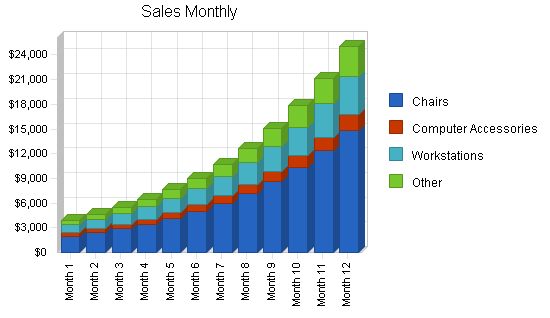
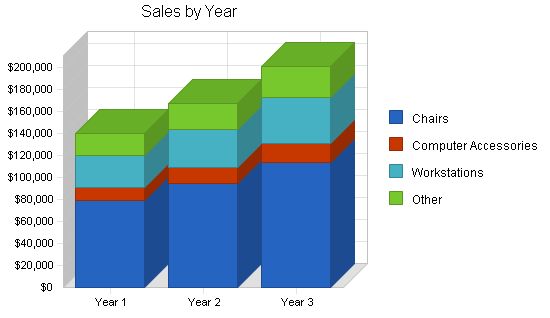
Contents
Sales Forecast
| Sales Forecast | |||
| Year 1 | Year 2 | Year 3 | |
| Chairs | $79,161 | $94,993 | $113,992 |
| Computer Accessories | $11,601 | $13,921 | $16,705 |
| Workstations | $29,002 | $34,802 | $41,762 |
| Other | $19,790 | $23,748 | $28,498 |
| Total Sales | $139,554 | $167,464 | $200,957 |
| Direct Cost of Sales | Year 1 | Year 2 | Year 3 |
| Chairs | $39,581 | $41,560 | $43,638 |
| Computer Accessories | $5,800 | $6,091 | $6,395 |
| Workstations | $14,501 | $15,226 | $15,987 |
| Other | $9,895 | $10,390 | $10,910 |
| Subtotal Direct Cost of Sales | $69,777 | $73,266 | $76,929 |
5.4 Milestones
The following table lists our initial milestones for the launch of WorkChairs, along with the start date, expected completion date, responsible employee, and department. Although we are not rushed to get this business going, it is crucial for us to hit our milestones on time before the slow summer season. We plan to use the summer season to refine our website and establish strong relationships with our manufacturers. To track our progress, we will utilize the Plan vs. Actual feature of Business Plan Pro® PREMIER.
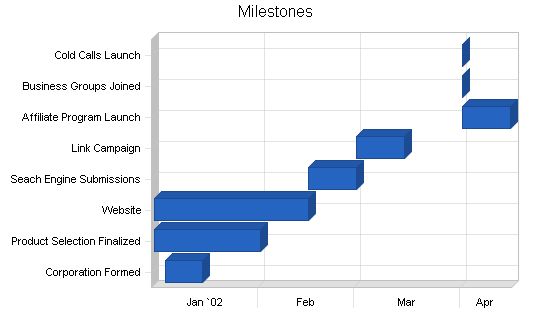
Milestones:
– Corporation Formed: 1/4/2002 – 1/15/2002, $1,000 budget, Jake (Manager), Executive Department
– Product Selection Finalized: 1/1/2002 – 2/1/2002, $0 budget, Jake and Lisa (Managers), Executive Department
– Website: 1/1/2002 – 2/15/2002, $75 budget, Peter (Manager), Web Department
– Search Engine Submissions: 2/15/2002 – 3/1/2002, $500 budget, Peter (Manager), Web Department
– Link Campaign: 3/1/2002 – 3/15/2002, $0 budget, Peter (Manager), Web Department
– Affiliate Program Launch: 4/1/2002 – 4/15/2002, $0 budget, Peter (Manager), Web Department
– Business Groups Joined: 4/1/2002, $0 budget, Jake and Lisa (Managers), Executive Department
– Cold Calls Launch: 4/1/2002, $0 budget, Jake (Manager), Sales Department
– Totals: $1,575 budget
Web Plan Summary:
The WorkChairs’ website will be a sales channel to the online world, providing both product information and educational resources on ergonomics.
The store section of our site will have a clean e-commerce design, featuring information about our products and how they solve people’s problems. It will also offer clear instructions on how to contact us for sales support and customer service.
The ergonomic information section will provide comprehensive information about health problems caused by office working conditions, along with solutions and links to relevant products. This section will establish WorkChairs as an expert in the field.
6.1 Website Marketing Strategy:
Our online marketing strategy includes:
– Search Engine Listings: We will pay for listings in paid inclusion engines and submit to free engines like Google. Our site will be search-engine friendly.
– Pay-per-click Advertising: We’ll have a limited monthly budget for targeted ergonomic keywords on Google and Overture.
– Link-building Campaign: Our educational resources will help us get links from other sites in relevant industries.
– Affiliate Program: We will offer an affiliate program that pays other websites 10% for referred sales.
– Word of Mouth: Visitors will find it easy to share our site with others.
6.2 Development Requirements:
The development of the WorkChairs website will start on January 1, 2002, and finish on February 15, 2002. Peter Wilson will handle all aspects of development.
– Front End: The website’s user interface will have a simple design with familiar e-commerce features.
– Back End: The site will use a mySQL database and PHP programming for fast, customized e-commerce functionality.
– Administration: An easy-to-use interface will allow Jake and Lisa Wilson to add, edit, and delete products and content.
– Future Development: Peter Wilson will continue working part-time on developing new features and marketing the website.
Management Summary:
WorkChairs is owned and managed by Jake and Lisa Wilson, with Peter Wilson as the website manager. There are no immediate plans to hire additional employees.
– Jake Wilson has over 30 years of experience in the office supply/furniture and ergonomics industry. He will work as the President and local salesperson for WorkChairs.
– Lisa Wilson has over 30 years of experience and will handle accounting and organizational aspects.
– Peter Wilson is an expert in web development, online sales, and online marketing. He will be in charge of the website and its marketing.
7.1 Personnel Plan:
The accompanying Personnel Table outlines the salaries of the three employees of WorkChairs. Jake and Lisa Wilson will not receive salaries until the business has sales in the middle of the year. Peter Wilson will be paid a modest salary from the start, which will slightly increase in 2003.
Financial Plan:
WorkChairs aims to keep expenses low while slowly and steadily growing sales. The business expects to have a positive cash balance at all times.
Key Assumptions:
WorkChairs assumes that interest rates and tax rates will remain stable. The business believes that its goals and projections are attainable given the current state of the economy.
8.1 Break-even Analysis:
The Break-even Analysis is based on the average revenue per sale. WorkChairs aims for a keystone mark-up of 100%. Monthly fixed costs include three salaries and operating expenses. The table and chart below calculate the break-even point in revenue per month.
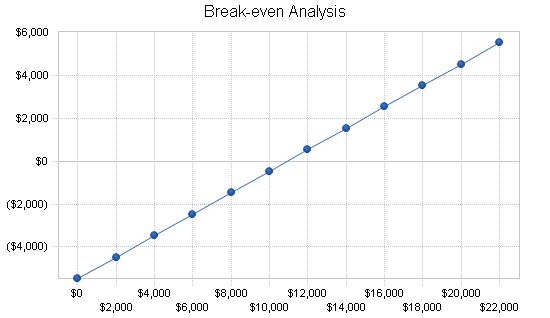
Break-even Analysis
Monthly Revenue Break-even: $10,950
Assumptions:
– Average Percent Variable Cost: 50%
– Estimated Monthly Fixed Cost: $5,475
Projected Profit and Loss
The accompanying Profit and Loss table demonstrates how we will minimize expenses and payroll as we increase sales. This may result in a slight loss in 2003, but we anticipate profitability from 2004 onwards. Our sales projections are conservative, and we hope to achieve profitability in 2003 based on these estimates.
Our objective is to maintain a high gross margin, which we believe will improve over time as we acquire more customers. This will allow us to avoid price competition with other retailers.

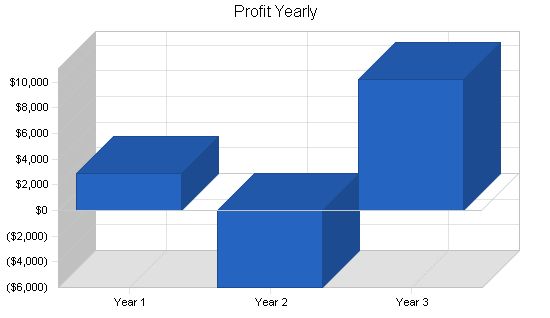
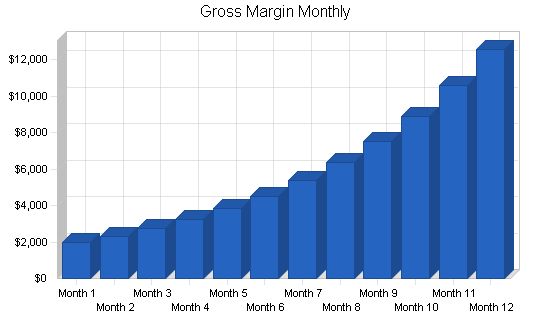
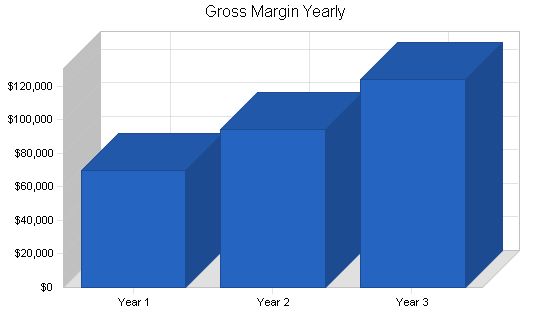
Pro Forma Profit and Loss
| Pro Forma Profit and Loss | |||
| Year 1 | Year 2 | Year 3 | |
| $139,554 | $167,464 | $200,957 | |
| $69,777 | $73,266 | $76,929 | |
| $0 | $0 | $0 | |
| $69,777 | $73,266 | $76,929 | |
| $69,777 | $94,198 | $124,028 | |
| 50.00% | 56.25% | 61.72% | |
| $54,000 | $84,000 | $92,000 | |
| $1,200 | $1,200 | $1,200 | |
| $0 | $0 | $0 | |
| $0 | $0 | $0 | |
| $0 | $0 | $0 | |
| $1,200 | $1,200 | $1,200 | |
| $8,100 | $12,600 | $13,800 | |
| $1,200 | $1,200 | $1,200 | |
| $65,700 | $100,200 | $109,400 | |
| $4,077 | ($6,002) | $14,628 | |
| $4,077 | ($6,002) | $14,628 | |
| $0 | $0 | $0 | |
| $1,223 | $0 | $4,388 | |
| $2,854 | ($6,002) | $10,240 | |
| 2.04% | -3.58% | 5.10% | |
8.4 Projected Cash Flow
Our Projected Cash Flow table and chart show that we have little risk in this business as we’ll always keep a sizeable cash balance. We have a projected period of three months in the slow summer period were we’ll see a negative net cash flow, but our balance will stay positive so we’ll be able to pay our bills and stay in the positive.
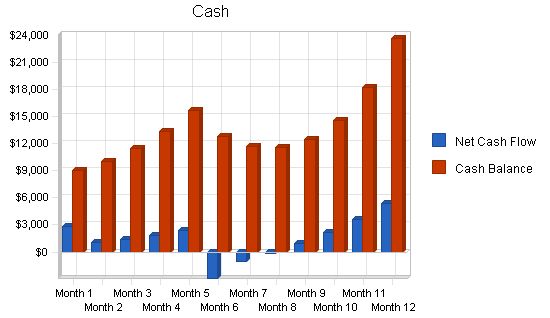
| Pro Forma Cash Flow | |||
| Year 1 | Year 2 | Year 3 | |
| Cash Received | |||
| Cash from Operations | |||
| Cash Sales | $139,554 | $167,464 | $200,957 |
| Subtotal Cash from Operations | $139,554 | $167,464 | $200,957 |
| Additional Cash Received | |||
| Sales Tax, VAT, HST/GST Received | $0 | $0 | $0 |
| New Current Borrowing | $0 | $0 | $0 |
| New Other Liabilities (interest-free) | $0 | $0 | $0 |
| New Long-term Liabilities | $0 | $0 | $0 |
| Sales of Other Current Assets | $0 | $0 | $0 |
| Sales of Long-term Assets | $0 | $0 | $0 |
| New Investment Received | $0 | $0 | $0 |
| Subtotal Cash Received | $139,554 | $167,464 | $200,957 |
| Expenditures | Year 1 | Year 2 | Year 3 |
| Expenditures from Operations | |||
| Cash Spending | $54,000 | $84,000 | $92,000 |
| Bill Payments | $68,052 | $96,760 | $97,957 |
| Subtotal Spent on Operations | $122,052 | $180,760 | $189,957 |
| Additional Cash Spent | |||
| Sales Tax, VAT, HST/GST Paid Out | $0 | $0 | $0 |
| Principal Repayment of Current Borrowing | $0 | $0 | $0 |
| Other Liabilities Principal Repayment | $0 | $0 | $0 |
| Long-term Liabilities Principal Repayment | $0 | $0 | $0 |
| Purchase Other Current Assets | $0 | $0 | $0 |
| Purchase Long-term Assets | $0 | $0 | $0 |
| Dividends | $0 | $0 | $0 |
| Subtotal Cash Spent | $122,052 | $180,760 | $189,957 |
| Net Cash Flow | $17,501 | ($13,296) | $11,000 |
| Cash Balance | $23,676 | $10,380 | $21,381 |
8.5 Projected Balance Sheet
WorkChairs aims to gradually grow its net worth and cash reserves. By 2004, the company expects to have a comfortable cushion of cash while still providing decent salaries for its three employees.
| Pro Forma Balance Sheet | |||
| Year 1 | Year 2 | Year 3 | |
| Assets | |||
| Current Assets | |||
| Cash | $23,676 | $10,380 | $21,381 |
| Other Current Assets | $2,000 | $2,000 | $2,000 |
| Total Current Assets | $25,676 | $12,380 | $23,381 |
| Long-term Assets | |||
| Long-term Assets | $0 | $0 | $0 |
| Accumulated Depreciation | $0 | $0 | $0 |
| Total Long-term Assets | $0 | $0 | $0 |
| Total Assets | $25,676 | $12,380 | $23,381 |
| Liabilities and Capital | Year 1 | Year 2 | Year 3 |
| Current Liabilities | |||
| Accounts Payable | $14,647 | $7,353 | $8,114 |
| Current Borrowing | $0 | $0 | $0 |
| Other Current Liabilities | $0 | $0 | $0 |
| Subtotal Current Liabilities | $14,647 | $7,353 | $8,114 |
| Long-term Liabilities | $0 | $0 | $0 |
| Total Liabilities | $14,647 | $7,353 | $8,114 |
| Paid-in Capital | $12,000 | $12,000 | $12,000 |
| Retained Earnings | ($3,825) | ($971) | ($6,973) |
| Earnings | $2,854 | ($6,002) | $10,240 |
| Total Capital | $11,029 | $5,027 | $15,267 |
| Total Liabilities and Capital | $25,676 | $12,380 | $23,381 |
| Net Worth | $11,029 | $5,027 | $15,267 |
8.6 Business Ratios
The following table outlines important ratios from the Office Furniture industry. The final column, Industry Profile, details specific ratios based on the industry’s Standard Industry Classification (SIC) code, 5712.9904. Our Gross Margin and profit ratio are projected to increase from 2002-2004, although there will be a dip in 2003 due to an increase in expenses.
| Ratio Analysis | |||||||||||||
| Year 1 | Year 2 | Year 3 | Industry Profile | ||||||||||
| Sales Growth | 0.00% | 20.00% | 20.00% | 2.90% | |||||||||
| Percent of Total Assets | |||||||||||||
| Other Current Assets | 7.79% | 16.15% | 8.55% | 22.82% | |||||||||
| Total Current Assets | 100.00% | 100.00% | 100.00% | 85.19% | |||||||||
| Long-term Assets | 0.00% | 0.00% | 0.00% | 14.81% | |||||||||
| Total Assets | 100.00% | 100.00% | 100.00% | 100.00% | |||||||||
| Current Liabilities | 57.05% | 59.40% | 34.70% | 39.96% | |||||||||
| Long-term Liabilities | 0.00% | 0.00% | 0.00% | 11.39% | |||||||||
| Total Liabilities | 57.05% | 59.40% | 34.70% | 51.35% | |||||||||
| Net Worth | 42.95% | 40.60% | 65.30% | 48.65% | |||||||||
| Percent of Sales | |||||||||||||
| Sales | 100.00% | 100.00% | 100.00% | 100.00% | |||||||||
| Gross Margin | 50.00% | 56.25% | 61.72% | 33.55% | |||||||||
| Selling, General & Administrative Expenses | 47.96% | 59.83% | 56.62% | 20.02% | |||||||||
| Advertising Expenses | 0.00% | 0.00% | 0.00% | 2.63% | |||||||||
| Profit Before Interest and Taxes | 2.92% | -3.58% | 7.28% | 0.94% | |||||||||
| Main Ratios | |||||||||||||
| Current | 1.75 | 1.68 | 2.88 | 1.95 | |||||||||
| Pro Forma Balance Sheet | |||||||||||||
| Month 1 | Month 2 | Month 3 | Month 4 | Month 5 | Month 6 | Month 7 | Month 8 | Month 9 | Month 10 | Month 11 | Month 12 | ||
| Assets | Starting Balances | ||||||||||||
| Current Assets | |||||||||||||
| Cash | $6,175 | $8,990 | $10,035 | $11,456 | $13,326 | $15,725 | $12,795 | $11,743 | $11,580 | $12,473 | $14,621 | $18,261 | $23,676 |
| Other Current Assets | $2,000 | $2,000 | $2,000 | $2,000 | $2,000 | $2,000 | $2,000 | $2,000 | $2,000 | $2,000 | $2,000 | $2,000 | $2,000 |
| Total Current Assets | $8,175 | $10,990 | $12,035 | $13,456 | $15,326 | $17,725 | $14,795 | $13,743 | $13,580 | $14,473 | $16,621 | $20,261 | $25,676 |
| Long-term Assets | |||||||||||||
| Long-term Assets | $0 | $0 | $0 | $0 | $0 | $0 | $0 | $0 | $0 | $0 | $0 | $0 | $0 |
| Accumulated Depreciation | $0 | $0 | $0 | $0 | $0 | $0 | $0 | $0 | $0 | $0 | $0 | $0 | $0 |
| Total Long-term Assets | $0 | $0 | $0 | $0 | $0 | $0 | $0 | $0 | $0 | $0 | $0 | $0 | $0 |
| Total Assets | $8,175 | $10,990 | $12,035 | $13,456 | $15,326 | $17,725 | $14,795 | $13,743 | $13,580 | $14,473 | $16,621 | $20,261 | $25,676 |
| Liabilities and Capital | |||||||||||||
| Month 1 | Month 2 | Month 3 | Month 4 | Month 5 | Month 6 | Month 7 | Month 8 | Month 9 | Month 10 | Month 11 | Month 12 | ||
| Current Liabilities | |||||||||||||
| Accounts Payable | $0 | $2,465 | $2,911 | $3,440 | $4,067 | $4,810 | $4,562 | $5,609 | $6,852 | $8,329 | $10,083 | $12,168 | $14,647 |
| Current Borrowing | $0 | $0 | $0 | $0 | $0 | $0 | $0 | $0 | $0 | $0 | $0 | $0 | $0 |
| Other Current Liabilities | $0 | $0 | $0 | $0 | $0 | $0 | $0 | $0 | $0 | $0 | $0 | $0 | $0 |
| Subtotal Current Liabilities | $0 | $2,465 | $2,911 | $3,440 | $4,067 | $4,810 | $4,562 | $5,609 | $6,852 | $8,329 | $10,083 | $12,168 | $14,647 |
| Long-term Liabilities | $0 | $0 | $0 | $0 | $0 | $0 | $0 | $0 | $0 | $0 | $0 | $0 | $0 |
| Total Liabilities | $0 | $2,465 | $2,911 | $3,440 | $4,067 | $4,810 | $4,562 | $5,609 | $6,852 | $8,329 | $10,083 | $12,168 | $14,647 |
| Paid-in Capital | $12,000 | $12,000 | $12,000 | $12,000 | $12,000 | $12,000 | $12,000 | $12,000 | $12,000 | $12,000 | $12,000 | $12,000 | $12,000 |
| Retained Earnings | ($3,825) | ($3,825) | ($3,825) | ($3,825) | ($3,825) | ($3,825) | ($3,825) | ($3,825) | ($3,825) | ($3,825) | ($3,825) | ($3,825) | ($3,825) |
| Earnings | $0 | $350 | $949 | $1,842 | $3,084 | $4,740 | $2,058 | ($41) | ($1,447) | ($2,031) | ($1,637) | ($82) | $2,854 |
| Total Capital | $8,175 | $8,525 | $9,124 | $10,017 | $11,259 | $12,915 | $10,233 | $8,134 | $6,728 | $6,144 | $6,538 | $8,093 | $11,029 |
| Total Liabilities and Capital | $8,175 | $10,990 | $12,035 | $13,456 | $15,326 | $17,725 | $14,795 | $13,743 | $13,580 | $14,473 | $16,621 | $20,261 | $25,676 |
| Net Worth | $8,175 | $8,525 | $9,124 | $10,017 | $11,259 | $12,915 | $10,233 | $8,134 | $6,728 | $6,144 | $6,538 | $8,093 | $11,029 |

Business Plan Outline
- Executive Summary
- Company Summary
- Products
- Market Analysis Summary
- Strategy and Implementation Summary
- Web Plan Summary
- Management Summary
- Financial Plan
- Appendix
“>
Hello!
I’m Andrew Brooks, a seasoned finance consultant from the USA and the mind behind phonenumber247.com.
My career is built on a foundation of helping individuals and businesses thrive financially in an ever-changing economic landscape. At phonenumber247.com, my aim is to demystify the complex world of finance, providing clear, actionable advice that can help you navigate your financial journey with confidence. Whether it’s personal finance management, investment strategies, or understanding the nuances of market dynamics, I’m here to share insights and tools that can propel you towards your financial goals.
Welcome to my digital space, where every piece of advice is a step closer to financial clarity and success!
